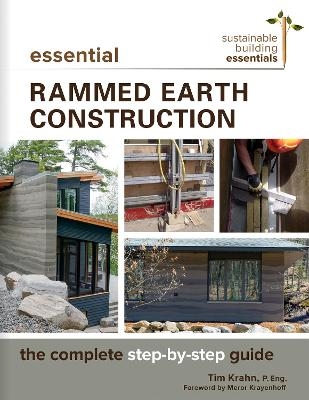
Essential Rammed Earth Construction
New Society Publishers (Verlag)
978-0-86571-857-9 (ISBN)
Everything you need to know to build with rammed earth in warm and cold climates.
Rammed earth - sand, gravel, and clay or lime/cement binder packed into forms - is a low-energy, high-performance building method, yielding beautiful, sustainable results. It's thermally stable and can be insulated, can actively modulate humidity, provides a healthy indoor environment, and allows site materials to be used for major structural and building envelope elements.
Essential Rammed Earth Construction covers design, building science, tools, and step-by-step building methods for any climate, with a special emphasis on building in cold climates of the northern US, Canada, and northern Europe. Coverage includes:
Overview of earthen building
Appropriate use of rammed earth walls
Stabilized versus raw rammed earth
Design considerations, including structural, insulation, and building envelope details
Special considerations for cold and freeze-thaw climates
Construction drawings, with step-by-step building instructions
Tools and labor covering industrial methods, low-tech techniques, formwork options, mix design, budgets, and schedules
Codes, inspections, and permits.
This guide is an essential resource for experienced builders, DIY home owners, designers, engineers, and architects interested in learning about rammed earth construction.
Tim J. Krahn, P. Eng. is a registered professional engineer and partner in Building Alternatives Inc., a consulting engineering company specializing in non-conventional structural and building envelope engineering with an emphasis on natural materials and energy efficiency. He holds a masters degree in geotechnical engineering and a bachelors degree in civil engineering from the University of Manitoba, and is a founding member of the Natural Building Engineering Group, the current chair of the Ontario Natural Building Coalition, and is active on the Renewable Materials task force of the Embodied Carbon Network. He received the first building permit for a rammed-earth structure in the city of Ottawa, and has been the structural engineer on more than twenty rammed-earth projects in Canada, including the first net-zero municipal building in Ontario, the Oxford County Municipal Solid Waste Office and Education Centre. He currently resides in Ontario, Canada.
Acknowledgments
Foreword By Meror Krayenhoff
Chapter 1: Introduction
Chapter 2: Rationale and Appropriate Use
Chapter 3: Building Science Notes
Chapter 4: Materials
Chapter 5: Wall System Examples and Structural Design Considerations
Chapter 6: Tools and Mixing
Chapter 7: Construction Methods
Chapter 8: Cost Estimates Based on a Cement-Stabilized Rammed Earth Project
Chapter 9: Wall Surfaces, Openings, and Embedments
Chapter 10: Building Code Developments
Appendix A: Sample Engineering Specification
Appendix B: Alternative Solutions Proposal
Definitions
Resources and Material Suppliers
Bibliography
Index
About the Author
A Note About the Publisher
| Erscheinungsdatum | 10.12.2018 |
|---|---|
| Reihe/Serie | Sustainable Building Essentials Series |
| Zusatzinfo | 24 Plates, color; 65 Halftones, black and white; 30 Line drawings, black and white |
| Verlagsort | Gabriola Island |
| Sprache | englisch |
| Maße | 216 x 279 mm |
| Gewicht | 544 g |
| Themenwelt | Sachbuch/Ratgeber ► Freizeit / Hobby ► Heimwerken / Do it yourself |
| Naturwissenschaften ► Biologie ► Ökologie / Naturschutz | |
| Technik ► Architektur | |
| Technik ► Bauwesen | |
| ISBN-10 | 0-86571-857-1 / 0865718571 |
| ISBN-13 | 978-0-86571-857-9 / 9780865718579 |
| Zustand | Neuware |
| Haben Sie eine Frage zum Produkt? |
aus dem Bereich


